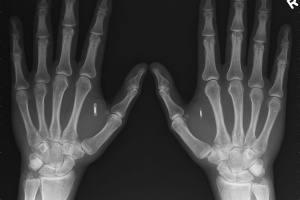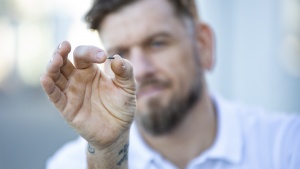Device implant
A device implant, sometimes referred to as a microchip, is a small technological device embedded under the skin. In humans, these often are types of integrated circuit devices or RFID transponders (radio frequency identifications). [1] Each RFID microchip contains a unique individual identification (ID) number and transmits a unique signal through radio waves that is then picked up by a reader and stored in a database. Law enforcement and security personnel, healthcare providers, and private individuals use device implants to hold identification and contact information.
Current devices are usually cylindrical and approximately the size of a grain of rice. The most common implant location is between the thumb and forefinger. Human implants, compared to microchips in animals, are contained in a glass case, which is not indestructible, but is hygienic for sub-dermal implanting. [2] Most implants rely on RFID technology, and some, more recently, also qualify as near-field communication (NFC) chips, a type of high-frequency radio wave communication. They do not require any charge or battery power, and so only function through radio wave sensing via a small antenna. [2]
Contents
History
The first known case of a human receiving an implant or microchip was British scientist Kevin Warwick, in 1998. He became the first human to test RFID surgery, and demonstrate the uses of a human microchip before having the chip removed after 9 days. [3] Warwick's demonstration paved the way for other scientists such as Mark Gassnon, who purposefully uploaded a computer virus onto his microchip, becoming the first human to be infected by a computer virus.[4]
Current uses
Human device implant technology has proliferated over the years, and has become a way to access information, and to store ticket codes, passwords, and more, reducing the need to carry keys, IDs, or remember login information. [5] It can be used to unlock cars, offices, or homes, or log on to technological devices or systems, such as phones or laptops. [2] Implants that are NFC compatible can also store Bitcoin or other virtual wallet addresses, and in Sweden, can carry citizens' regional train tickets. [2]
Jowan Osterlund started the firm Biohax International after a career as a professional body piercer. He says, "Having different cards and tokens verifying your identity to a bunch of different systems just doesn't make sense… Using a chip means that the hyper-connected surroundings that you live in every day can be streamlined." [6]
In recent years, the company Dangerous Things has become a leading producer and proponent of human device implants. [7] They suggest anywhere from 50,000 to 100,000 people worldwide have implants now. [2]
In 2017, the Wisconsin company Three Square Market made headlines after offering free microchipping to their employees. In August 2018, it was announced that they were seeking to upgrade the initially simplistic devices to more powerful ones, which would eventually include GPS tracking and voice activation. [8]
Healthcare
The healthcare industry has begun utilizing device implants for patient monitoring. Firms such as Three Square Market have begun seeking markets for GPS tracking chips for patients with mental health disabilities, such as Alzheimer’s or Dementia, and some chips have been developed to monitor vital health signs, or hold patient's personal medical records or medication lists. [8] [9] Devices such as cardioverter defibrillators[10] have greatly assisted the healthcare system, allowing doctors to monitor vital signs of patients outside of the office.
Firearm regulation
Amal Graafstra has begun developing an implant-activated ‘smart gun’, which can only be fired by the person with the matching implant ID. The idea is that this would make firearms more secure, by limiting them to a single user. [11] Currently, to create a smart gun technology is not always reliable given external factors that effect the "smart technology" ability to perform. Leveraging RFID's as device implant technology would increase the reliability of the owner's gun performance, and also add another level of control by only allowing guns to operate with the owners recognized RFI.
Popular culture depiction
The 2018 movie Upgrade focuses on certain styles of human device implants. The movie's characters have guns implanted in their arms, and some even have an implanted device that connects to their brain stem, able to control their bodily functions. In the movie, one of the devices becomes so smart that it instructs his user on how to hack himself, giving the device full control over their operator, without any need for consent or control. This raises a pressing ethical question that will need to be addressed before a similar situation makes its way into the modern day world. With these type of implants, future engineers will need to find a way to build in trust and human override or control, in order to ensure that a scenario, such as the one in Upgrade, does not happen.
Ethical considerations
While there is some concern for infection after implantation, and swelling or slight discomfort are typically expected after insertion, most companies work with experienced body piercers to reduce health risk. So, the debate with human device implants has largely been around the ethical complexity of using them. [2]
Data protection
The Agence France-Presse reported in May 2018: “Swedes have gone on to be very active in microchipping, with scant debate about issues surrounding its use, in a country keen on new technology and where the sharing of personal information is held up as a sign of a transparent society… Sweden has a track record on the sharing of personal information, which may have helped ease the microchip’s acceptance among the Nordic country’s 10 million-strong population.” [5] A local pioneer in human implants, Jowan Osterlund has stated that he believes “that if we carried all our personal data on us, we would have better control of their use.” [5]
However, this localized collection of data is what concerns some. Ben Libberton is a microbiologist at MAX IV Laboratory. He has summarized the greatest risk as having to do with the data collected on and by the chip. “At the moment, the data collected and shared by implants is small, but it’s likely that this will increase.” [5] He points to the looming question of collecting the data and deciding how to share, handle, or destroy it. [5] “The more data is stored in a single place as could happen with a chip, the more risk it could be used against us.” [5]
The chips can also be compromised, as explained by Tarah Wheeler, an information security researcher. Some of the technology can be cloned, allowing access to those who are not the owners of a chip and the ID data stored on it. [2]
Consent and monitoring
Some, including John Halamka, MD, also point out that patients would need to give consent for implantation before receiving a device, and that the progression of mental disease such as Alzheimer’s can make the timeline for this difficult to manage. [9] In time, the sharing and storage of medical health records, location history, or access codes presents opportunities for companies or other bodies to exploit customer data.
The American Medical Association has regulated the ethics of RFID implants for about 10 years, and has sought to protect consumer health data. [3] Many fear that the data collected from these devices could be collected and aggregated, and then lost or shared without the owner’s consent. Similarly, there is a fear that the devices might be forced upon a certain group for surveillance or exploitation, compromising their freedom and privacy. [3]
In the future, ethical issues such as tracking employees, or preferential hiring to those who agree to a chip, might arise. [12] Others argue that while right now the current models of microchips seem less risky, the issue is quickly becoming a slippery slope as the technology advances.
References
- ↑ https://en.wikipedia.org/wiki/Microchip_implant_(human)
- ↑ 2.0 2.1 2.2 2.3 2.4 2.5 2.6 https://arstechnica.com/features/2018/01/a-practical-guide-to-microchip-implants/
- ↑ 3.0 3.1 3.2 https://www.researchgate.net/publication/280933310_RFIDs_Chip_Implants_and_their_related_Ethical_Issues
- ↑ Gasson, Mark N. “Human Enhancement: Could You Become Infected with a Computer Virus?” Human Enhancement: Could You Become Infected with a Computer Virus? - IEEE Conference Publication, 7 June 2010, ieeexplore.ieee.org/document/5514651.
- ↑ 5.0 5.1 5.2 5.3 5.4 5.5 https://www.scmp.com/news/world/europe/article/2145896/thousands-people-sweden-get-microchip-implants-new-way-life
- ↑ https://www.npr.org/2018/10/22/658808705/thousands-of-swedes-are-inserting-microchips-under-their-skin
- ↑ https://www.dangerousthings.com/biohacking
- ↑ 8.0 8.1 https://www.washingtonpost.com/technology/2018/08/23/this-firm-already-microchips-employees-could-your-ailing-relative-be-next/?noredirect=on&utm_term=.5367229835b5
- ↑ 9.0 9.1 https://www.healthcareitnews.com/news/human-implantable-rfid-chips-some-ethical-and-privacy-concerns
- ↑ “Implantable Cardioverter Defibrillator (ICD).” Www.heart.org, 30 Sept. 2016, www.heart.org/en/health-topics/arrhythmia/prevention--treatment-of-arrhythmia/implantable-cardioverter-defibrillator-icd.
- ↑ https://motherboard.vice.com/en_us/article/pgkz8y/biohacking-smart-guns-RFID-implants-amal-graafstra
- ↑ https://www.digitalethics.org/essays/implanting-microchips-sign-progress-or-mark-beast

